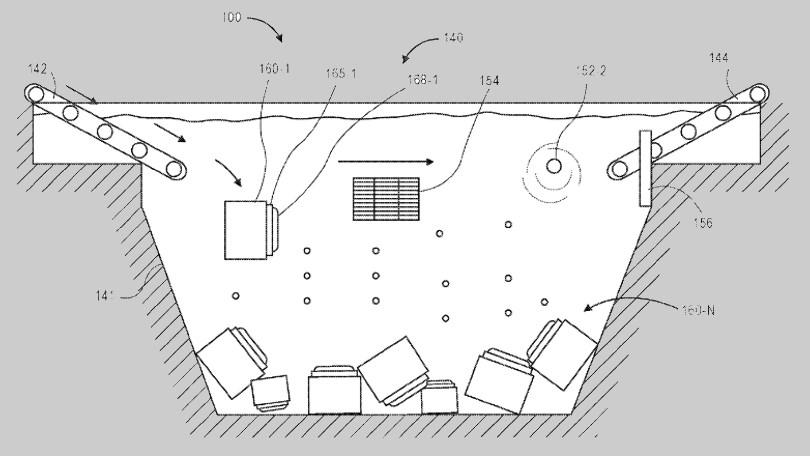Connecting the Dots on Amazon's patents in Logistics
/I've dug into Amazon's patent filings over the last five years and mined the patent titles for keywords related to inventory and logistics. Patents range from the mundane like optimization of packaging sizes and allocating regional inventory to reduce out-of-stock costs to the more technologically advanced like autonomous vehicles, mobile ground-based fulfillment centers, and drones. At the far end of the spectrum are topics that appear to be more the realm of sci-fi fantasy like underwater warehouses, airborne warehouses, and beehive-like warehouses, but hey, who knows.
The below chart shows Amazon's patent filings related to Logistics since 2012:
While many of these technologies may never be deployed, the patents reveal how Amazon thinks about the future of logistics and makes it crystal clear that Amazon views logistics and fulfillment technology as a core competency. Amazon is well known for obsessively focusing on the customer and the bulk of these patents will result in putting merchandise into their customer hands easier, faster, and for a lower cost. The patents also make it clear that Amazon is focused on taking full control of their distribution infrastructure to handle package delivery for itself, and eventually for others.
Here are some of the more interesting patents related to fulfillment and logistics:
Title: Anticipatory Package Shipping
Date Filed: August 2012
This patent is designed to cut delivery times by predicting what buyers are going to buy before they buy and then shipping packages to a geographical area without specifying the exact delivery address at the time of shipment. Amazon has been stockpiling data on customer preferences and buying habits for years and using predictive analytics makes sense to put that data to good use. Customers would essentially be outsourcing some of the more mundane recurring purchases to Amazon’s algorithm and free up their time to do other things. If it works, this could just become another reason to do more shopping on Amazon as well as allowing Amazon to further widen and deepen their competitive moat.
Patent: Aquatic storage facilities
Date Filed: September 2016
This is the most far out there patent for me (but actually makes sense) and proposes to store inventory in giant pools of liquid submerged under the ground or by temporarily storing parcels in lakes or rivers. The items stored in the pools would be outfitted with depth control devices that control the product’s density, causing it to sink or float to the surface. When a package is ready to be shipped a sound will be emitted to propel the package to the surface where it may be picked up by an employee, robot, or drone.
So, why does Amazon want to do this? The patent mentions that current warehouses are becoming increasingly large with complicated technology. Amazon stocks millions of products and some warehouses are larger than 1 million square feet and require pickers or robots to travel many miles throughout the day to pick orders. Underwater storage would bring a more efficient use of space, reduced travel time in the warehouse, and could be particularly useful for non standard-sized merchandise or merchandise that has highly variable demand.
Patent: Airborne fulfillment center utilizing unmanned aerial vehicles for item delivery
Date Filed: December 2016
Amazon has trialed delivering packages via drones in the U.K., but drones as currently constructed have a few fundamental flaws related to short range and the amount of energy required to pick up and deliver packages. To solve for these problems, this patent describes huge floating warehouses located at high altitudes where a network of drones would float down to make deliveries. From the abstract of the patent filing
"As the UAV’s descend, they can navigate horizontally toward a user specified delivery location using little to no power, other than to stabilize the UAV and/or guide the direction of descent."
The mobile nature of floating warehouses would also allow the drones to have greater delivery range and provide increased flexibility of locating the flying warehouse closest to the expected demand at any given day or time.
Patent: Multi-Level Fulfillment Center for Unmanned Aerial Vehicles
Date Filed: December 2015
This patent describes a future where packages are delivered quickly and on-demand via drones. In order to support this vision, Amazon imagines a giant multi-level beehive-like warehouses in urban areas where drones pick up packages for delivery and use the warehouse as a base station. Drones would be guided to a docking station and a robot or human would load up the drone with their next delivery.
Patent: Lane Assignments for Autonomous Vehicles
Date Filed: January 2017
This patent describes a way for autonomous cars to navigate reversible lanes where traffic flow changes based on demand. Amazon’s design includes a system that can communicate with autonomous cars so that traffic flow can be adjusted. Not as flashy as some of their other patents but it is a clear indicator that Amazon wants to continue to take more control of their delivery infrastructure by getting into autonomous cars and trucks. I wouldn't be surprised to see an acquisition in this space.
Title: On-demand Apparel Manufacturing
Date Filed: December 2015
2017 may well turn out to be a major tipping point in the history of apparel retail. Amazon has recently made waves in the apparel industry by launching Amazon Wardrobe which lets you try clothes before you buy them, and Amazon Echo Look, a cloud-connected fashion assistant that allows you to snap pictures of yourself in various outfits and serves up recommendations of what you should wear (and buy from Amazon). Clothing has been an eCommerce laggard, but according to Cowen and Co., Amazon is expected to surpass Macy’s this year to become the largest seller of apparel in America. By 2021, Cowen and Co., estimate that Amazon will generate $62 billion in apparel sales, about triple the expected sales in 2017.
This patent application is for on-demand manufacturing to quickly produce apparel only after a customer order is placed. The system would include textile printers, cutters and an assembly line, as well as an automated process to pack and dispatch orders. Orders could be aggregated from various geographic locations which would allow Amazon to manufacture on-demand at a massive scale. Need a new suit in a few hours? Maybe Amazon could manufacture custom fit apparel on-demand in an airborne warehouse and deliver by drone. This seems a natural fit for Amazon and will allow them to control the full end to end supply chain process for apparel while giving their customers ultimate convenience at the same time.
So, what are other large retailers and logistics companies doing in this space? Are they doing enough to keep up?
I cover forward-looking topics that are relevant for everyone interested in the future of logistics. You can read more articles here or sign-up for a free monthly newsletter here.
















